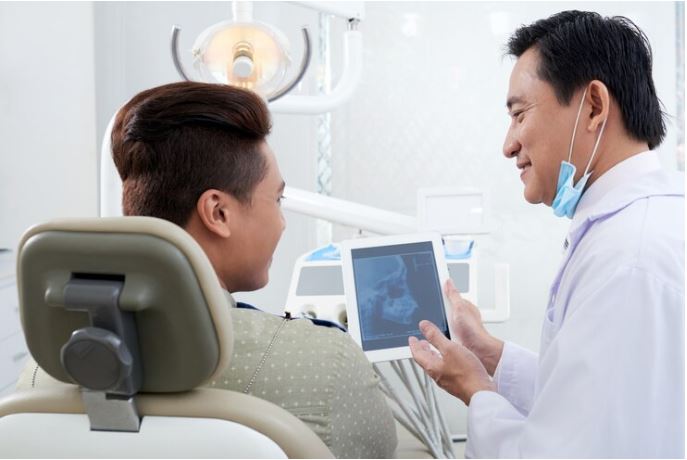
The Asian Journal of Dental and Health Sciences (AJDHS) has recently published a detailed case report titled “The Keys to Succeed in an Immediate Maxillary Complete Denture,” presenting groundbreaking insights into the effective application of immediate dentures. Authored by a team of dental experts, this report underscores the critical clinical and technical steps necessary to achieve successful outcomes in patients transitioning from partial to full edentulism.
Key Findings of the Journal Article
The study explores the treatment of a 52-year-old patient with severe tooth wear and partial edentulism. The primary focus is on implementing a maxillary complete denture and a mandibular partial denture, showcasing the meticulous clinical and laboratory procedures involved. Key findings highlight:
Clinical Execution: The article details the precise techniques for taking primary and secondary impressions. For instance, primary impressions were made using irreversible hydrocolloids to create individual trays for secondary impressions. The maxillary peripheral seal was constructed using Kerr® thermoplastic paste for the posterior and lateral regions and polyether for the anterior region. This ensures a secure and accurate fit, crucial for the denture’s stability and functionality.
Occlusion and Aesthetics: The orientation of the anterior occlusal plane was meticulously adjusted to match the patient’s aesthetic and phonetic needs. The anterior maxillary prosthetic teeth were positioned using a silicone key to replicate the natural teeth ‘ dimensions and shapes, ensuring a seamless transition for the patient. The correct occlusal vertical dimension was confirmed through a wax try-in phase, which allowed for adjustments before the final polymerization of the prosthesis.
Patient-Centric Approach: The report emphasizes the importance of addressing patients’ psychological and functional needs. For example, patients often prefer immediate dentures to avoid the social discomfort of edentulism. The case report details how patient satisfaction is achieved by ensuring the denture’s fit and function align with the patient’s aesthetic desires and comfort levels.
Post-Delivery Care: Follow-up care is highlighted as a critical factor for success. The patient was instructed to wear the denture continuously for the first 24 hours, followed by scheduled follow-up appointments at 5, 10, and 20 days. These sessions are essential for adjusting the denture, addressing discomfort, and reinforcing hygiene practices. Continuous monitoring helps maintain the denture’s stability and ensure the patient’s adaptation and satisfaction.
Technical Precision: The study outlines the importance of technical precision in each step, from the initial impressions to the final adjustments. Advanced materials like polyether and medium-viscosity polysulfide for impressions ensure detailed capture of the oral structures, which is critical for the denture’s accuracy and comfort.
Pallav Dave the reviewer of the article gave a professional summary to help improve the overall quality of the paper.
Strengths:
Detailed Methodology: The journal exhaustively describes each procedural step, offering valuable insights for dental practitioners. It includes detailed diagrams and photographs that illustrate the process, enhancing understanding and application.
Practical Application: A real-life case study enhances the practical application of the discussed techniques. The report bridges the gap between theoretical knowledge and clinical practice by presenting actual clinical scenarios.
Evidence-Based: The findings are well-founded and reliable, supported by references to numerous studies and clinical evaluations. This evidence-based approach ensures that the recommendations are grounded in proven scientific research.
Patient-Focused Care: Emphasizing patient satisfaction and psychological well-being, the report showcases the importance of holistic dental care beyond mere clinical procedures.
Weaknesses:
Scope Limitation: The case report focuses on a specific patient profile, which may limit the generalizability of the results to broader patient populations. Each patient may have unique anatomical and psychological considerations that require tailored approaches.
Resource Intensiveness: The procedures outlined require significant clinical expertise and resources, which might be challenging in under-resourced settings. The need for specific materials and skilled practitioners may only be feasible in some dental practices.
Follow-Up Intensity: The recommended follow-up schedule is intensive, which may not be practical for all patients due to time and financial constraints. This could limit the procedures’ applicability in everyday clinical practice.
About the peer reviewer
Pallav Dave, the peer reviewer of this research, is a seasoned Regulatory Compliance Analyst based in Kentucky, USA. With extensive experience in healthcare compliance and public health research, Pallav brings a wealth of knowledge and expertise to this groundbreaking study. This research shows his commitment to improving public health outcomes through innovative community-based interventions. Pallav’s work focuses on identifying practical solutions to enhance healthcare access and quality, particularly for underserved populations.





